1450, On Madeira, Portuguese develop slave-worked sugar cane plantations. They require construction of hundreds of miles of irrigation canals, all by African slaves who first arrive in mid-1440s (perhaps Berbers from Arguin). First sugar mill opens around 1452. By century’s end, Madeira is Europe’s leading source of sugar and an early model for New World slave plantations to come.
Tenant-farming develops later, and eventually becomes the dominant system on island’s plantations.
Note: Sugar cane requires considerable land as soil nutrients are exhausted quickly; considerable water and, for centuries, intensive labor for planting and cutting, with considerable downtime in between.
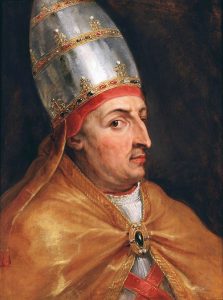 Nicholas V.
Nicholas V.
1452, Pope Nicholas V issues Dum Diversas bull authorizing Afonso V of Portugal to conquer and enslave Saracens and pagans (into “perpetual servitude”) in a bid to win more Western Europe support for the besieged Byzantine Empire.
Reaffirmed and expanded by Nicholas in 1455, and by Calixtus III, 1456; Sixtus IV, 1481; and Leo X, 1514.
Viewed widely in Europe as papal endorsement of slave trade past and future, as long as Christians do not enslave those already Christian.
1453, Sultan Mehmed II leads Ottoman Turks’ capture of Constantinople and final defeat of Byzantine empire (the last vestige of the Roman Empire), May 29.
Thousands of men, women and children sold into slavery. Inaugurates long state of war between Ottoman Turks and Western Europeans.
Further obstructs trade from Mediterranean via already-difficult Red Sea and Silk Road routes; this spurs Portuguese search for route around Africa to India and Far East and, eventually, Columbus’s scheme to reach the Far East by sailing west.
Westward migration of Byzantine scholars helps revive Greek and Roman studies, which, in turn, nourishes Renaissance science and humanism. Some historians regard Constantinople’s fall as the beginning of “modern times.”
1453, Hundred Years’ War effectively concludes with English defeat at Battle of Castillon, and the final fall of Bordeaux and Aquitaine to France, July 17. National identities are strengthened; feudalism and chivalry decline. The long war also distracted England and France from aiding the Byzantines.
Note: France’s kings suffered defeat after defeat until 1429 when teenaged Joan of Arc inspired the French people to unify.
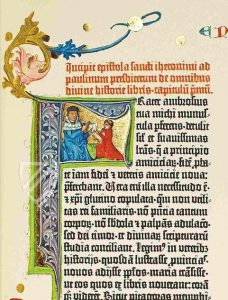 From Gutenberg Bible.
From Gutenberg Bible.
1454, Johannes Gutenberg prints Bibles with a press, mass-produced moveable type and oil-based ink, revolutionizing publishing and communication. In Mainz.
1455, In wake of fall of Constantinople, Henry sends Alvise Cadamosto, a Venetian, to resume exploration of African coast. On the Grande Côte north of Cape Verde, he trades seven horses and woolen goods to Wolof people for 100 slaves, then sails south to find mouth of Gambia river. Barely fends off a Mandinka attack in massed canoes.
The trade with the Wolof is an early model for what will become the basic means of procuring slaves: Buying them from African coastal kings who gather them in wars and raids on neighboring (usually interior) peoples.
1460, Prince Henry dies, age 66, near Sagres, west of Lagos, Nov. 13.
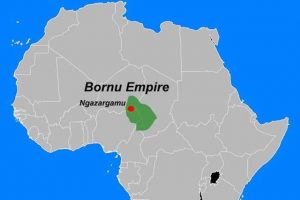 A rising empire.
A rising empire.
1460, Ali Gazi begins consolidation of Muslim Bornu empire west of Lake Chad (in present-day Nigeria), building walled capital at Ngazargamu.
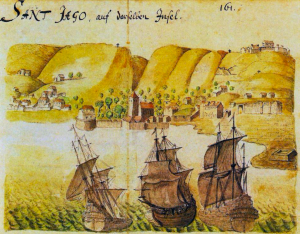
Portuguese settlers arriving in Santiago.
1461, Portuguese establish settlement of Ribeira Grande on Cape Verde island of Santiago, the first European colony in sub-Sahara Africa. The new governor, António da Noli, a Genoese, is officially credited with discovery of the islands.
Portuguese soon discover that islands’ low rainfall and warm, steady winds somehow dramatically reduce the chance of disease. They also discover that islands are prone to severe drought.
Ribeira Grande (today’s Cidade Velha) develops into a major takeoff port for long-range expeditions (Da Gama and Columbus will both use it) and into an important slave entrepôt by 1500.
1462, Portugal’s Pedro de Sintra reaches (and names) Sierra Leone and possibly goes much further. But there are few details in the record of this voyage.
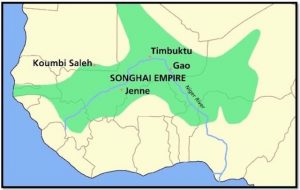 Songhai Empire on the map.
Songhai Empire on the map.
1468, Songhai Empire, led by Sunni Ali Ber, expands from its capital, Gao, up both sides of the Niger river to capture Timbuktu (previously held by fading Mali Empire and then by Tuareg tribes). The two river cities are important departure points for trans-Sahara trade of African gold and slaves to Morocco (Sijilmassa) and even to Tripoli.
The empire also absorbs the fertile Macina (the Niger’s vast inner delta), taking Djenné in 1475.
The Sunni rulers practice Islam, but allow various peoples and local chiefs to maintain traditional religions.
1469, Portugal’s Afonso V grants Fernão Gomes a monopoly of melegueta pepper trade in the Gulf of Guinea if he advances exploration of the West Africa coast over the next five years.
Gomes organizes successful voyages of De Sintra, João de Santarém, Pedro Escobar, Lopes Gonçalves and Fernão do Pó.
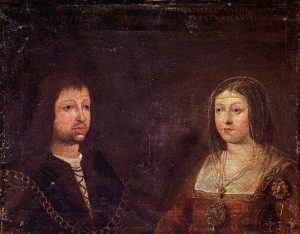 Isabella and Ferdinand.
Isabella and Ferdinand.
1469, Isabella of Castile, 18, marries Ferdinand of Aragon, 17, Oct. 19. Second cousins, they are destined to be the Reyes Católicos, uniting their kingdoms into what will be called "Espagñe" after they ascend their respective thrones.
1470, Gomes’s navigators establish Portugal’s first trading post on the Gold Coast, the source of river gold that intrigued Henry at Ceuta 56 years earlier. They quickly establish a new gold trade with Fante people and call the post El Mina (“the mine”) rendered later as Elmina.
De Santarém and Escobar encounter 330-square mile São Tomé in Gulf of Guinea, Dec. 21, 1471. The following month, they cross the equator (perhaps the first Europeans to do so) to discover tiny Annobón (7 square miles) and then sail north to find Príncipe (53 square miles).
Largest of this line of volcanic islands, Fernando Po, is named for its 1472 discoverer. It lies just 60 miles off coast, and is the only one where they find inhabitants.
Gonçalves charts coast from Wouri river (called Rio dos Camarões by Portuguese for its teeming shrimp, which leads to name of present-day Cameroon) to Cabo Santa Catarina (now Cape Lopez, Gabon), 1473.
1471, Afonso V finally conquers Tangier for Portugal, Aug. 28, after taking Arzila to the south with a huge fleet (400 ships) and army (30,000 strong), supported in part by first gold from Elmina. They build new fortifications, improve the port and hold the city against Muslim opponents for 190 turbulent years. Afonso is dubbed “El Africano.”
Battle of Arzila is commemorated in the four large Pastrana Tapestries, woven in Tournai and displayed at the Colegiada de Pastrana in Spain since 1664.
1474, Prince João of Portugal (the future João II) is credited with reinforcing decks on caravels to support heavier guns capable of sinking enemy ships. Portugal will lead Europe in developing naval gunnery into the next century.
1475, Death of Henry IV of Castile leads to rival claims to throne from Isabella, Henry’s half-sister, and from Juana, Henry’s underage daughter, who marries the widowed Afonso V of Portugal. Four years of war follow between Portugal and Castile, the latter supported by Aragon.
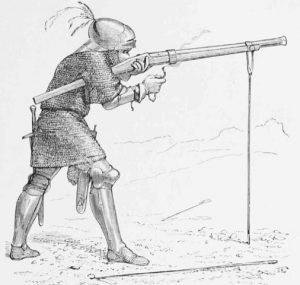 Soldier using a matchlock.
Soldier using a matchlock.
1475, The matchlock arquebus (the matchlock is the first trigger) is developed by this year. It is considered the first portable shoulder firearm, and is soon essential to European warfare. The term “musket” is first applied to versions of the flintlock appearing in late 1600s.
1478, Castilian fleet of 35 ships descends on Gold Coast to usurp Portugal’s Elmina monopoly of gold trade. Eleven Portuguese warships arrive two months later, surprising the Castilians anchored in lagoon. In a decisive victory, Portuguese capture the entire Castilian fleet, including thousands of sailors and soldiers, and a treasure of gold.
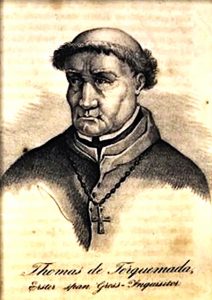 Tomas de Torquemada.
Tomas de Torquemada.
1478, Although Ferdinand and Isabella are not yet monarchs, Ferdinand prevails upon Pope Sixtus IV to extend Aragon’s inquisition to Castile, and to give them full control, Nov. 1. The Spanish Inquisition focuses on the large number of Jewish (Converso or Marrano) and Moorish (Morisco) families who have converted under pressure to Catholicism since the pogroms of the late 14th century.
Ferdinand and his grand inquisitor, Tomás de Torquemada, fear the growing economic power of both groups, and question their dedication to the church. They suspect that many Jews and Moors remain secretly loyal to their old faiths.
An estimated 2,000 people, most of them Jewish conversos, are executed over the next 50 years, many burned at the stake. Note: The Inquisition has no authority over Jews and Moors who continued to affirm their old religions. Instead, they face deportation, or death if they refuse to leave.
1479, Ferdinand ascends to throne of Aragon, Jan. 20. War of Castilian Succession ends with Isabella’s victory over Juana of Portugal for throne, Sept. 4. With both Isabella and Ferdinand unchallenged, unity of Spanish monarchy is well underway. But Treaty of Alcáçovas also guarantees Portugal control of West African coast and all Atlantic islands that may be discovered south of the Canaries.
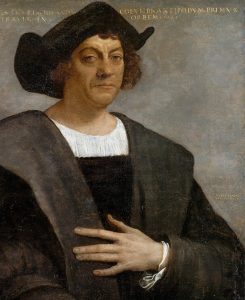 Christopher Columbus.
Christopher Columbus.
1479, Christopher Columbus, originally from Genoa, marries Filipa Moniz Perestrelo, daughter of Portugal’s first donatario of Porto Santo (himself originally from Lombardy). The couple moves from Lisbon to Porto Santo where she gives birth to son Diego. Later they move again to Madeira, where Columbus encounters the first slave-worked sugar plantations.
Another Madeira-Genoa connection: Genoese merchants are said to provide capital for Madeira sugar mills.
Madeira overtakes Cyprus as the leading producer of sugar by the 1490s, sending 70 shiploads annually to Antwerp alone.
1481, In the Canaries, Isabella and Ferdinand launch various expeditions to finally overcome native Guanche population on Gran Canaria and block Portuguese interest in islands. Isabella’s policy is not to enslave, but to subjugate and convert to Christianity; the Guanche continue to resist both.
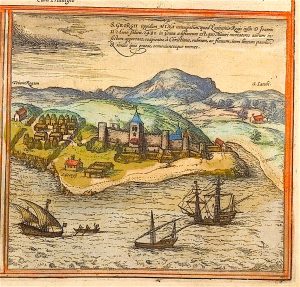 Gold Coast.
Gold Coast.
1481, To solidify Portugal’s position on Gold Coast against another attack, new King João II orders formidable stone construction of Castle de São Jorge at Elmina.
The outpost supports gold trade with dominant Fante people, who have long used captives from northern regions to mine gold from their streams. At first, Portuguese bring more enslaved to Elmina to pay for gold.
One source says Columbus joined a voyage to this fort, and may have experienced the volta da Mina, the clockwise ocean current that carries ships west from the Gold Coast before turning north toward Europe.
By 1500, more than 56,000 ounces of gold have been shipped from Elmina to Lisbon.
It is considerably later that Elmina evolves into a slave depot for the trans-Atlantic trade. Captives are held for weeks, even months, until ships arrive to transport them across the Atlantic.
1482-1484, João II sends Diogo Cão in a single ship to probe the African coast further south. After a stop at new Elmina fort, he sails south of equator and discovers the Congo estuary, August. He trades with Bakongo people, who guide four of his men to meet their king; they exchange themselves for four native ambassadors.
Cão sails further south to present-day Cape St. Mary (Angola) before setting course for home. Remnants of stone pilars (dedicated to Order of Christ) that he erects at the Congo’s mouth (Shark Point) and Cape St. Mary can be seen in place today.
1483, João II acts against unruly Portuguese nobles, led by duke of Braganza who has been plotting assassination of João with Isabella of Castile. João orders death for dukes of Braganza and Viseu (the latter by his own hand), and confiscates vast properties. Many others slain, including the bishop of Évora.
1484-1486, Shortly after Cão’s return, April, João II sends him on a second voyage. This time, he ascends Congo (with hope of finding the world of Prester John). He finds Matadi, where he returns the Kongo ambassadors for his own men, but is stopped by the Yellala Falls.
He erects more pilars, at Cape Negro in Angola and Cape Cross (present-day Namibia), and reaches Ponta dos Farilhões near present-day Walvis Bay) where he apparently dies.
His voyages (see map) pave the way for Dias and Da Gama.
1486, Portuguese open Casa dos Escravos (House of Slaves) on Lisbon’s Tagus waterfront to process African captives and set prices. By 1512, it is estimated that blacks, both slave and free, make up 10% of Lisbon’s 65,000 people, far more than in any other European city.
By 1550, blacks, many assigned to work the ever-busy docks, are established in the waterfront Mocambo district (taking the Kimbundu word for “hideout”). Term is also applied to runaway-slave communities that develop in Brazil.
 Dias's small caravels.
Dias's small caravels.
1487-1489, Following up Cão, Bartolomeu Dias sails southward with four ships, far off coast of Angola and Namibia, and finally discovers open water around Africa to the Indian Ocean, February, 1488. Finds land and erects stone cross at present-day Kwaaihoek, South Africa, and touches at the Cape of Good Hope on return.
1487, Meanwhile, João II sends Arabic-speaking Pêro da Covilhã on a secret mission across the Mediterranean to Rhodes (where he and a partner purchase a cargo of honey and disguise themselves as Arab merchants) and then on to Alexandria, Cairo and Aden, at the south end of Red Sea.
At Aden, Da Covilhã crosses Indian Ocean in a dhow to Calicut, a hub of the Indian spice trade. His mission is to question captains and pilots, scout out winds and currents, map Arab trade routes and report on regional politics. He next visits Goa and reaches Ormuz, another spice-trade hub (at the mouth of the Persian Gulf), late 1488.
Da Covilhã then sails down east coast of Africa to Sofala (near present-day Beria, Mozambique). He returns to Cairo by 1491, to give his first lengthy report to two Jewish emissaries from João II familiar with Arabia. One of these returns to Portugal via Aleppo and the Mediterranean, after giving Da Covilhã new royal orders to seek the mythical King Prester John, believed then to be in Ethiopia.
Da Covilhã traverses Arabia, including Medina and Mecca, before striking inland from Gulf of Aden for Ethiopia. He is welcomed by young Emperor Eskender, given many honors and permitted to communicate with Lisbon. But he is never permitted to leave and dies in Ethiopia sometime after 1526.
Da Covilhã’s reconnaissance and reports are vital to success of Vasco da Gama’s 1499 voyage around Africa and across the Indian Ocean to Calicut.
1487, Mali empire’s mansa (king) welcomes Portuguese envoys Pêro d'Évora and Gonçalo Enes, but fails to win their support for an alliance.
1488, Uprising of native Guanche on La Gomera in the Canaries soon after sugar-cane production begins. Unpopular Hernán Peraza the Younger, lord of the island, is killed by a Guanche leader. More than 200 rebels die in retaliation, with hundreds more, including children, sold into slavery.
Peraza’s widow, Beatriz de Bobadilla y Ossorio, becomes the countess of La Gomera and El Hierro, and will assist Columbus four years later.
Note: Beatriz, previously a member of the court of Isabella and Ferdinand, is said to have engaged in an affair with the king. Isabella arranged her 1482 marriage to Peraza. Beatriz’s month-long encounter with Columbus is said to involve romance as well.
1490-1537, Fulo people, who hold Futa Djallon highlands (in present-day Guinea), expand into the Gambia. Their Islamic kingdom is then defeated in its attack on Songhai empire to northeast.
Regrouping under Koli Tenguella, Fulo are more successful in attacking Wolof empire north of the Gambia, and establishing the Futa Toro region on the Senegal river. These conflicts likely generate many captives among the contenders.
1492, Granada capitulates, ending last Muslim kingdom in Iberia, Jan. 2. Catholic monarchs promise Muslims they may retain religious rights, but issue Alhambra Decree expelling practicing Jews. More than 200,000 Jews had converted in decades before the decree and tens of thousands more afterward. But between 40,000 and 100,000 depart, first for Portugal (but only for eight months) and then to Mediterranean countries (including Muslim kingdoms) and to the Netherlands. They comprise the Sephardim branch of Judaism.
Later, Isabella and Ferdinand turn on Muslims of Granada and Morisco converts in other parts of Castile and Aragon.
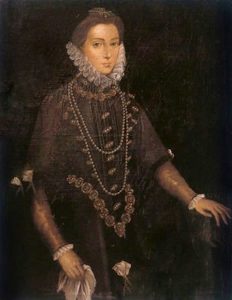 Queen Isabella
Queen Isabella
1492, Columbus’s First Voyage, on behalf of Isabella and Ferdinand, departs Palos, Aug. 3. Sails via La Gomera (where he is aided by the countess, Beatriz). The Santa Maria’s pilot is Pedro Alonso Niño (called El Negro) born in Moguer, near Palos. His father is said to have been an African sailor captured at Elmina.
Columbus first encounters New World and its people in form of San Salvador island in Bahamas and Taíno Indians. Sails on to Cuba and then Hispaniola, where the Santa Maria founders and where a first settlement, La Navidad, is established on north coast with 39 men, mostly Santa Maria crew. Columbus finally sails to Puerto Rico with the Nina and Pinta.
Columbus returns via Azores and Lisbon (where he informs João II of his discoveries) to Palos, March 15, 1493. Arrives with several Taíno captives.
Colombus’s report to the Reyes Católico is widely published in Europe, April, 1493. Because he significantly underestimates earth’s circumference, Columbus believes to his dying day that he has found out-islands of Asia. His contract with the Reyes Católico makes clear that gold, gems and spices are their mutual goal, and that he will receive 10 percent.
1493, Álvaro Caminha establishes first settlement on São Tomé in Gulf of Guinea. Portugal’s João II deports convicts and hundreds of young Jewish children (originally from Castile) to São Tomé, where many die working on early sugar plantations. Decades later, some descendants of Jewish survivors make their way to Brazil.
1493, Askia Muhammad ascends throne of Songhai Empire as its first dedicated Muslim ruler. He will make it the grandest empire yet in West Africa, seize salt mines of Taghazza from fading Mali Empire, develop trade on Saharan routes, open schools to introduce Islam to masses, usher in a golden age for the scholars of Timbukto and conduct a fabulous hajj to Mecca.
Many slaves taken during this expansion are incorporated into Askia’s army and his Niger river fleet.
But empire goes into decline after Askia’s overthrow by sons in 1528.
1493, Columbus’s Second Voyage with 17 ships (and more than 1,000 skilled workers and settlers) departs Cádiz, September, with instructions from Isabella to treat Indians humanely (similar to less-than-successful policy on Canary Islands). He also brings sugar-cane seedlings.
Columbus sails via El Hierro (Canaries) and Dominica Passage, to various of the Lesser Antilles (a crewman and several Carib Indians die in a small battle on Saint Croix) and to Hispaniola, where the Navidad settlement has been wiped out by Taínos under Caonabo, the first large confrontation between Europeans and Indians. Columbus makes no attempt to puniush Taínos and appears to have accepted their report of Spanish misbehavior and misteatment of Taíno women.
A new settlement, La Isabela, is established, also on the north coast, only to be ravaged by the first-known European-introduced epidemic in the New World, and then hammered in 1494 and 1495 by huge storms, which the Taínos call “hurricanes.”
1494, Columbus’s lieutenants stir up more trouble with various Taíno bands while probing interior of Hispaniola, and accomplish no baptisms as Isabella and Ferdinand had directed.
Columbus sets up encomienda system, with monarchs granting Columbus and “worthy” conquistadors control of Taíno bands for agriculture and, mainly, for gold mining in streams.
Duties of the encomiendero: To provide Indians “protection” and Christian teaching in return for their forced labor. The system, which will be applied widely in Spanish New World, was first established in Andalusia for Moriscos and Conversos (converted Moors and Jews).
While Isabella and Ferdinand are convinced this system is more humane to Indians than chattel slavery—they are not to be bought and sold and continue to live in their homelands—they are otherwise exploited as slaves with no right to refuse work or to deny authority of, and punishment by, the encomiendero.
1494, Treaty of Tordesillas, sought by Isabella and Ferdinand when Portugal’s João II threatens to send fleet to seize Hispaniola (which would seem to be in Portuguese zone under 1479 Treaty of Alcáçovas).
The new treaty, June 7, separates spheres of control along a meridian 370 leagues (1,185 miles) west of Cape Verde Islands. This keeps Hispaniola and Caribbean in the hands of the Reyes Católicos.
Isabella and Ferdinand don’t know it, but this also places Brazil in the eastern, Portuguese, zone when Brazil is claimed in 1500. Sanctioned by Pope Julius II, 1506.
The Line of Demarcation assures that most of the New World lands that are to be exploited will be in Spanish hands, while virtually all the Africans that will be enslaved for plantations will be in the Portuguese sphere.
For the first 150 years of the Atlantic slave trade, Brazil is the only New World land for which one nation, Portugal, completely controls the source and the assignment of African slaves.
1494, Guanche, on their last-stand Canary island of Tenerife, ambush invading Castilian forces under Alonso Fernández de Lugo, who loses 80 percent of his men, May 31.
But De Lugo returns 19 months later with a larger, better-trained force, defeating the Guanche leader, Bentor, whose forces may have been weakened by disease.
Guanche finally yield, July 1496, after decades of resistance. Most are enslaved.
Note: The 12,188-foot Tiede volcano dominates Tenerife. The Guanche believe it to be the home of the hell-demon Guayota.
1495, In February, Columbus’s Taíno captives on Hispaniola number 1,500; he sends 500 to Cádiz on 12 ships; 200 die during the voyage. Most survivors die soon after arrival.
Columbus defeats Taíno in first pitched battle between Native Americans and Europeans, and completely subjugates them (under encomienderos) to mine gold from streams. By 1508, Taíno population is down to 50,000 from estimated 250,000 at discovery.
A new settlement is established on south coast by Columbus’s brother, Bartholomew, to replace La Isabela. By year’s end, two thirds of settlers are dead from disease and famine.
But this will become Santo Domingo, the oldest continuously occupied European settlement in the Americas, and Spain’s Caribbean headquarters for more than 300 years.
1495, Portugal’s king, João II, dies at 40 after reinvigorating explorations of African coast and reconnaissance of Indian Ocean. Manuel I succeeds him.
1496, Columbus returns to Cádiz from Second Voyage, June 11. He brings back 200 unhappy colonists and pleads for more supplies.
1497-1499, Vasco da Gama’s famous voyage from Lisbon, which reaches Calicut (present-day Kozhikode, India), May 20, 1498. Sailing via Tenerife, Sierra Leone, the Cape of Good Hope, Mozambique, Mombasa and Malindi—and back—he pioneers the great ocean trade route from Europe to Asia.
Da Gama’s four ships sail 6,000 miles of open ocean between Sierra Leone and the Cape of Good Hope over more than three months, the longest passage beyond sight of land to that date.
1498-1500, Columbus’s Third Voyage departs Sanlúcar with six ships, May 30. From La Gomera, half the fleet (with new settlers) heads directly for Hispaniola; But Columbus heads south to Cape Verde Islands and then west to Trinidad, Margarita and then Santo Domingo. There he is eventually arrested by governor after disputes over settlers and enslavement of Taíno, and is sent back to Cádiz in chains, October 1500. Isabella and Ferdinand hear Columbus’s plea, then free him and brothers.
1499, Amerigo Vespucci, a Florentine, is the navigator on the first of his two voyages, which discovers the mouth of the Amazon. He claims it for Castile and Aragon.
1455, Portuguese build fort on a cliff at Arguin, and open trade with Berbers for gold and black slaves brought north by caravan to the westernmost oases at Ouadane, 270 miles away.
